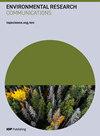Asian summer monsoon responses under RCP4.5 and RCP8.5 scenarios in CESM large ensemble simulations
IF 2.9
4区 环境科学与生态学
Q3 ENVIRONMENTAL SCIENCES
引用次数: 0
Abstract
The response of the Asian Summer Monsoon (ASM) circulation to the Representative Concentration Pathway 4.5 and 8.5 (RCP4.5 and RCP8.5) forcing scenarios is examined using the CESM1 state-of-the-art global circulation model from 2021 to 2050. The projections show that monsoon precipitation will increase over East Asia, the North Pacific Ocean, the Indian Peninsula, and the Bay of Bengal under the RCP4.5 scenario. Conversely, the South Indian Ocean, West Asia, the Middle East, and the Central Pacific Ocean exhibit a decreasing trend in precipitation. Under the RCP8.5 scenario, precipitation is projected to increase over a wider swath of the Indian Ocean and the Middle East Asia. In the RCP4.5 scenario, the low-level wind circulation is likely to strengthen over the entire northern Indian Ocean, extending to the South China Sea, thereby increasing moisture transport from the Indian Ocean to peninsular India and the South China Sea. Conversely, in the RCP8.5 scenario, easterly winds strengthen over the South Indian Ocean, leading to an increase in moisture transport from the equatorial West Pacific Ocean to the Indian Ocean. A weak (strong) cyclonic circulation in response to the east-centered (west-centered) low sea level pressure trend over the North Pacific in RCP4.5 (RCP8.5) scenario is projected to help maintaining a strong (weak) ASM circulation from the India to east Asia. Internal climate variability is also calculated, revealing that the North Pacific Ocean near the Bering Sea is likely to play a dominating role and contribute significantly to the future ASM dynamics. In both scenarios, internal variability is found to substantially contribute to changes in monsoon circulation over the Indian Ocean.CESM 大集合模拟中 RCP4.5 和 RCP8.5 情景下的亚洲夏季季风响应
利用 CESM1 最先进的全球环流模式,研究了 2021 至 2050 年亚洲夏季季风环流对代表性浓度途径 4.5 和 8.5(RCP4.5 和 RCP8.5)强迫情景的响应。预测结果显示,在 RCP4.5 情景下,东亚、北太平洋、印度半岛和孟加拉湾的季风降水量将增加。相反,南印度洋、西亚、中东和中太平洋的降水量则呈下降趋势。在 RCP8.5 情景下,预计印度洋和亚洲中东部更大范围的降水量将增加。在 RCP4.5 情景下,整个印度洋北部的低层风环流可能会加强,并延伸至中国南海,从而增加从印度洋到印度半岛和中国南海的水汽输送。相反,在 RCP8.5 情景中,南印度洋上空的东风增强,导致从赤道西太平洋到印度洋的水汽输送增加。在 RCP4.5(RCP8.5)情景下,北太平洋上空以东为中心(以西为中心)的低海平面气压趋势预计将导致弱(强)气旋环流,有助于维持从印度到东亚的强(弱)ASM 环流。对内部气候变率也进行了计算,结果表明,白令海附近的北太平洋可能会发挥主导作用,并对未来的 ASM 动力做出重大贡献。在这两种情况下,内部变率都会对印度洋季风环流的变化产生重大影响。
本文章由计算机程序翻译,如有差异,请以英文原文为准。
求助全文
约1分钟内获得全文
求助全文

 求助内容:
求助内容: 应助结果提醒方式:
应助结果提醒方式:


